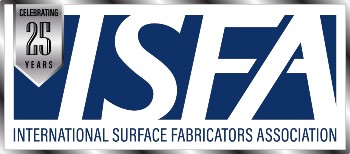LaminateOverview of Decorative Laminate CountertopsHigh pressure decorative laminate (or simply plastic laminate) is often referred to by the name “Formica,” which was the company that originally invented it, although there are numerous brands available. It is one of the most popular and affordable surface materials used for countertops today. The durability and wide-array of color and apparent texture makes laminate easily incorporable into virtually any kitchen or bathroom design and has moved beyond countertops into the artistic design arena itself. The term “plastic laminate” is often misunderstood and taken to be an inferior material, but that is not necessarily the truth. Plastic laminate contains very little actual plastic, to the tune of about 18 percent. The majority of laminate is decorative paper pressed together with plastic resins in a high-heat environment. The laminate sheets are then bonded to a substrate material, such as plywood, particle board, or fiberboard to give them their strength and durability. Colors Laminate countertops can come in any color imaginable. In the past, black and white speckled patterns were popular as well as solid tans and off-whites, but with the change in trends, patterns including geometric shapes, checkerboards, various sized dots, and swirled colors came into use. Today, many prefer a gray metallic that resembles stainless steel. Natural colors and textures are also highly desirable like wood grains and stone patterns such as granite, marble, and slate. Deep-running mineral veins can also be added for an extra touch. Laminate was first patented in 1913 by two engineers from Westinghouse, Herbert A. Faber and Daniel J. O’Conor, continuing on the work of Belgian Chemist Leo Bakeland. Faber and O’Conor founded the Formica Insulating Company in the same year. The earliest uses of laminate were for electric and industrial insulation in the form of rings and tubes but by 1914, Formica had started producing laminate in flat pressed sheets. The patterns were added to laminate by Formica in 1927 and soon it was being used in a wide range of products such as radios, airplane interiors, and soda fountains. Improvements continued steadily through the 1930s and 1940s to make it more attractive, durable , and resistant to cigarette burns. Formica’s new improved laminate was soon integrated into countertops and with their success came competition. The Laminate Market Although Formica is the most well-known producer of laminate, there are several other companies that manufacture laminate. Formica is hard pressed by three competing companies: Wilsonart was founded in 1956 not to be a competitor but to fill the time of retired executive Ralph Wilson Sr. His hobby brought him further than he expected and they now have 15 facilities worldwide. Pionite, a division of Panolam Industries, has been in the laminate business for more than 60 years. They manufacture laminate for several industries and provide hundreds of colors and styles. Nevamar is also a division of Panolam Industries and it strives to provide an excellent product through its patented ARP technology that provides great lasting power in their laminates.
|
